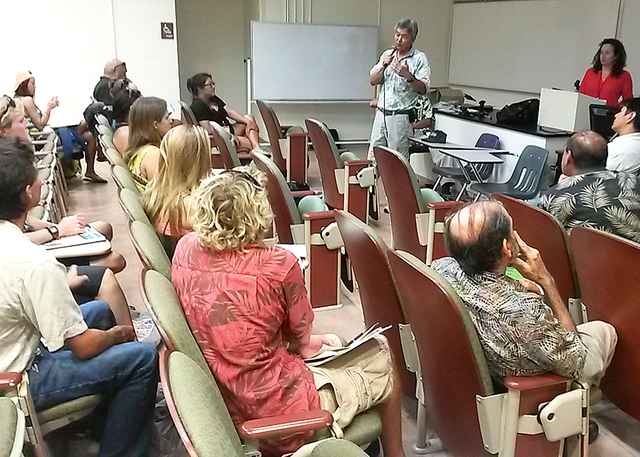When it comes to managing a resource as vast as the ocean, it takes a cooperative effort.
A Thursday forum on the final day of the 23rd annual Hawaiian Conservation Conference addressed the importance of reaching out to local fishermen and incorporating them into the bigger picture of protecting the marine ecosystem.
Panelists at the event, which was held this week in Hilo, stressed that it’s only through open communication and outreach that this goal can be achieved.
“What historically has happened … is like magic,” panelist Tom Ogawa said.
Ogawa said that when fishermen, already distrustful of government officials and wary of talking about their lifestyle, did share information about their catches, the data tended to get crunched into rules limiting their fishing with little explanation for why or what the benefit might be.
Ogawa is the project manager for the Hawaiian Marine Recreational Fishing Survey, an effort launched in 2001 to gain a better sense of how many noncommercial anglers were fishing in the state, and what their catches were. Commercial fishermen are required to log their catches, which allows for more accurate assessments of fish stocks to be taken. But there hadn’t been a concerted effort to track what was happening in the recreational world before.
To collect fisheries data about noncommercial anglers, Ogawa and his staff pound the pavement, visiting shore-fishing spots and public boat ramps to speak with the fishermen directly. It takes years to break the ice and build relationships, but when it works, it results in successes like the Ulua Tagging Project.
Fishermen tagged and released undersized ulua that they weren’t going to keep. Over time, the tagged fishes’ growth and migrations were tracked, providing valuable information for understanding the ecology of the fish.
“There was feedback,” said Earl Miyamoto, coordinator for the Department of Land and Natural Resource’s Marine Wildlife Program. For that reason, he said, “Fishermen loved it.”
Throughout the forum, speakers emphasized the need for these small victories in the context of a larger battle.
“It’s a long-term process,” Miyamoto said. “People have to anticipate being in it for the long haul.”
Miyamoto spoke from personal experience. As a boy, he and his brothers fished nearly every day to bring home food for their family. When he was younger, some of the biggest trouble spots for current recreational fishermen — hooking endangered honu or monk seals, for example — barely existed because their populations weren’t yet on the rebound.
“In the first 20 years of my life, I hardly saw any turtles, and no monk seals,” Miyamoto said.
As populations continue to recover, he anticipates more unwanted interaction (“Most fishermen don’t want to hook an animal at all,” he said), making the need for outreach all the more important.
It was equally important, Miyamoto said, for the conservation community to not have a knee-jerk reaction and view fishermen as bad for the ecosystem.
“If you think about it, fishermen are conservationists,” he said. “They’re probably more interested than most people in terms of having a healthy ocean.”
“Nobody wants to stop fishing,” Ogawa said. “They just want to sustain our resources so we can continue to eat fish.”
Even seemingly insignificant changes — using pliers or a crimper to press the barb of a fishing hook flat against the hook itself — can have an impact. The barbless circle hook still holds bait and catches fish, but it’s not as dangerous to other marine life. If a monk seal gets hooked, for example, it’s far easier to release the animal or for the hook to fall out on its own.
Kurt Kawamoto, project manager for the Pacific Islands Fisheries Science Center Barbless Circle Hooks Project, estimated that he gives away between 15,000 and 25,000 barbless circle hooks every year. These are purchased from local fishing supply stores at retail prices as a means of supporting the entire fishing community.
“What it does is it gives fishermen a tool,” Kawamoto said. He estimates that usage rates among noncommercial fishermen are about 40 percent.
“To have that many fishermen change is huge,” Miyamoto said.
Miyamoto will be in Hilo this weekend giving away hooks at the S. Tokunaga Store, on Saturday from 10 a.m. to 1 p.m.
Part of that effort is showing kids how to make the barbless circle hooks. After all, it’s the keiki who will be most affected by the changes made now.
“We’re trying to influence the next generation,” Miyamoto said.
Email Ivy Ashe at iashe@hawaiitribune-herald.com.



